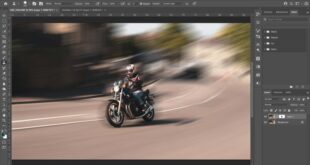How To Use Color Dynamics In Photoshop For Vibrant Artwork – In this Photoshop tutorial, you’ll learn how to create a brand-new composition from a blank canvas. We’ll guide you through basic tools and techniques—from using the Pen Tool to applying brushes, filters, and capture tools—to help you transform shapes and with simple colors and good designs. Whether you want to create creative advertising materials or develop your own unique photo effects, these methods can be easily accessed by beginners in Photoshop. In the end, you’ll have the confidence to apply what you’ve learned to public policy projects. Let’s dive in and revive your vision!
The composition is a well-designed decorative art, created in images that combine elements of surrealism, abstraction and modern pop-art influences. The subject – a woman’s face – emerges from a fluid, swirling background of beautiful colors, bold shapes and flowing lines. Instead of a simple scene, the image is divided into bright, colorful patches, as if paint has been poured, swirled and carved onto the surface.
How To Use Color Dynamics In Photoshop For Vibrant Artwork
Circles in glowing hues surround the image’s head like floating bubbles, giving a sense of dynamism and depth. These three-dimensional circles appear, standing out against soft streams, like the ribbons of the back pig. The palette is bold and distinctive, encompassing bright yellows, fiery reds, pinks, turquoises and earthy blacks, all integrated into a solid, prismatic landscape.
How To Use Photoshop Blending Modes For Fine Art Portraiture
The overall style is reminiscent of modern photography techniques, often seen in editorial design, advertising and concept art. There are touches of pop surrealism, the face and the image are visible, but very beautiful, an abstract painting concept, as if traditional mixing and blending has been translated into a digital format. The interplay of hard and soft surfaces, combined with color and smooth transitions, creates a sense of movement and fluidity, drawing attention with its composition and beautiful color scheme.
Create a new document using these 2500×1500 dimensions and use 300dpi for resolution. It is better to do this because later you may want to print the composition, and saving it in high resolution is necessary.
It doesn’t matter what color you fill in the form because you will start adding colors right away. Using the Pen Tool (P) to create solid images you need to create some images like the image below. Define these shapes using the colors #ff9c00 for top, #00d2ff for bottom right, #ad08f6 for center, and #e50000 for bottom left.
Add a soft orange gradient to the top using the Blending Options option. You can activate the Blending Options option by double-clicking on the layer. When the Blending Options window opens, enter the Gradient Overlay and normal gradient options using the colors as shown in the image below #ff1e00, #ffde00, #ffde00.
16 Dynamic Photoshop Effects Bundle
Duplicate the top orange layer before using the transform option by pressing Command/Ctrl + T to change the shape slightly by dragging the right corner down a few inches. This is just to create a depth of character.
Using Command/Ctrl + Click on the first orange layer to select the layer. Then create 2 more layers and using a soft black brush of different sizes start brushing the edges of the selection and set the layers to Overlay 28% and 12% .
Start creating 2 new white shapes with the Pen Tool (P) and place them on top of the double orange layer. Set 2 new layers to Overlay 50% and 25%.
Create a shape like the image below using the Pen Tool (P). Also note, any variables you create must be included in a new class to take full effect. This style is made so that you can make some candles so don’t worry about the color.
Illustration Masterclass: Painting With Color Dynamics
Hold Command/Ctrl and click the layer to select, then you can make the layer invisible but keep the selection. Create a new layer and set it to Soft Light. Using a soft brush set on white, you need to brush the edges of the selection. This technique will help you achieve the abstract style and effect you are looking for.
Repeat the last 3 steps and continue creating the same abstract images until you get the same result as the image below. A little different from the other 3 steps above, you can add some white objects set to Soft Light in the corners of the shape you created. Look to add a glossy finish.
Continue adding lines to the edges of the orange shape using the Pen Tool (P). First, set the Brush to white, size 2 px. Select dynamics shape, 0% size jitter and control pen pressure. Set the Pen Tool to just a path but create short paths on the edges of the shape as shown in the image below, then right click and select Stroke Path. Make sure the brush is selected and Pressure Simulation is checked. These prints will be duplicated in different layers and set to Soft Light and 35%, 24%. Experiment with settings.
Create a small circle on the orange area with the Elliptical Marquee Tool (M) and then go to Blending Options and add a Gradient Overlay. Set a Gradient with the colors #ff6f00 and #ffea00.
Create A Surreal Desert Scene In Photoshop
Select the second layer of the orange color and before you start adding colors you need to create a new layer and set it to Hue and 60%. Now you need to start adding some color to the orange pattern using a soft brush. If you start adding color to the right of the orange shape, you should use the same shade of blue as the color next to it and repeat this for the rest of the shape.
Duplicate the layer after you’ve added the soft colors and set the layer to Hue and 20% fill.
You are done with the orange part of the composition for no. Now it’s time to start making the blue part and as you did with the orange part you will repeat the steps for the blue part.
Add a soft shadow into the shape. The shadow will be added using the Blending > Inner Shadow options.
The Influence Of Light And Color In Digital Paintings Of Environmental Issues On Emotions And Cognitions
Start adding soft white shadows over the blue area as you did with the orange area.
Use a soft brush with colors from the composition to add new color over the blue area as you did in the previous steps. Also use the Pen Tool (P) to create images with white color like the image below.
The green area should be clear now. Then start making the purple part and again use the same technique as above. You should experiment freely and play with the images until you get a result that pleases you.
Add a large white glow over the purple area using the Pent Tool (P) as seen in the image below. Then continue with adding glitter and colorful reflections. Follow the image below for information.
Ai Art, Inspirations & Opinion Blog
Finally, continue working on the red area and use the same techniques again. At the end of this editing, the composition will be taken to the form of composition. Everything should be colorful and almost delicious.
Using a large soft brush you need to add 3 dots of color with blue, purple and yellow. The locations of these locations are marked in the image below. Color codes: #f3eb16, #c9ee22 and #02fcff. Set the layers of these points to Lightness 50%.
Create a Levels layer using the following settings: RGB – 0, 1.00, 255; RED – 0, 0.75, 255; Green – 0, 0.87, 255; 0 , 1.24 , 255. Finally, create a black and white gradient map and set it to Luminosity. Place these 2 layers on top of all the other layers created so far when these effects apply to the image.
Go to the Blending options for the layer you created in the circle and add an Inner Shadow by setting the color to black and the Multiply option. Opacity 26%, angle 39, distance 4, choke 0, size 174.
How To Make Your Own Color Palettes
Make a selection around the circle, then using a soft black brush you need to add 3 dots of shadow on every other layer, then set them to Normal 49% and others in Multiply are set to 13% and 24%.
Make another selection around the circle, but this time you will add a white layer to create a shiny and light effect. Set the layer to Overlay.
Using the Gradient Tool (G) you need to create a gradient set to White – Transparent.
Create a new shape like the image below (a drop of water in this case a drop of light) and fill it
 Alveo Creative Blog Guiding users through techniques for enhancing images, retouching portraits, and mastering popular editing software
Alveo Creative Blog Guiding users through techniques for enhancing images, retouching portraits, and mastering popular editing software




